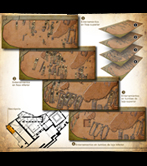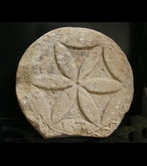The Santa Teresa necropolis
Below the staircase that leads up to the church in what is now the convent of Santa Teresa, in the old part of Donostia, there are the remains of an old cemetery with different levels of occupation, which might be described as follows:
Burials in the upper grave: tombs made out of sandstone ashlar and covered with sloping lids, of which there were some 20 in a simple grave. Most of the cadavers were lying supine facing the East with their hands crossed over the stomach. A third were young people. Two disc-shaped sandstone steles, associated with funerals, have been found.
Burials in the lower grave: The skeletons of 15 adults and two children, all positioned on their backs and facing East. The skeletons were all laid out in exactly the same manner and were practically touching the upper level of the tombs. A copper belt buckle was found on the pelvis of one body, the only artefact found at this level. Two pieces of sandstone steles have been found.
Burials in tombs on the upper slab: tombs made up of slabs facing East, most of them rectangular, narrowing towards the feet and with earrings at the head end. The lids were made of irregular layers of ashlar about 10 cm thick, although these were missing from one of the tombs. Three funereal steles were found near the slab tombs, two of them disc-shaped and decorated on both sides, and the other rectangular without any decoration or inscription.
Burials on the lower slab: children’s burial area, facing East, lying on their backs with their arms close by their sides, with a slab at the head end and another at the foot end. They were not buried with any sort of artefacts, except with two small stones propping up their heads.
The necropolis extends towards the church of Santa Maria, while the part towards the interior of the convent of Santa Teresa has disappeared.
Carbon dating shows that the graves date from the last third of the 10th century until the end of the 15th. It dates back, therefore, to before the foundation of Donostia as a villa, and is perhaps associated with the nearby church of Santa Maria. The cemetery was gradually abandoned, possibly between the 15th and 16th centuries, when it became common to be buried inside the church and outdoor cemeteries fell into disuse.




